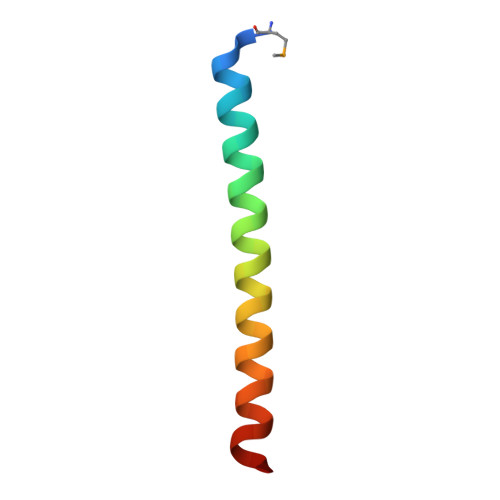Crystal structure of the C-terminal four-helix bundle of the potassium channel KCa3.1.
Ji, T., Corbalan-Garcia, S., Hubbard, S.R.(2018) PLoS One 13: e0199942-e0199942
- PubMed: 29953543
- DOI: https://doi.org/10.1371/journal.pone.0199942
- Primary Citation of Related Structures:
6D42 - PubMed Abstract:
KCa3.1 (also known as SK4 or IK1) is a mammalian intermediate-conductance potassium channel that plays a critical role in the activation of T cells, B cells, and mast cells, effluxing potassium ions to maintain a negative membrane potential for influxing calcium ions. KCa3.1 shares primary sequence similarity with three other (low-conductance) potassium channels: KCa2.1, KCa2.2, and KCa2.3 (also known as SK1-3). These four homotetrameric channels bind calmodulin (CaM) in the cytoplasmic region, and calcium binding to CaM triggers channel activation. Unique to KCa3.1, activation also requires phosphorylation of a single histidine residue, His358, in the cytoplasmic region, which relieves copper-mediated inhibition of the channel. Near the cytoplasmic C-terminus of KCa3.1 (and KCa2.1-2.3), secondary-structure analysis predicts the presence of a coiled-coil/heptad repeat. Here, we report the crystal structure of the C-terminal coiled-coil region of KCa3.1, which forms a parallel four-helix bundle, consistent with the tetrameric nature of the channel. Interestingly, the four copies of a histidine residue, His389, in an 'a' position within the heptad repeat, are observed to bind a copper ion along the four-fold axis of the bundle. These results suggest that His358, the inhibitory histidine in KCa3.1, might coordinate a copper ion through a similar binding mode.
- Kimmel Center for Biology and Medicine of the Skirball Institute, Department of Biochemistry and Molecular Pharmacology, New York University School of Medicine, New York, NY, United States of America.
Organizational Affiliation:


















